-
Paper Information
- Paper Submission
-
Journal Information
- About This Journal
- Editorial Board
- Current Issue
- Archive
- Author Guidelines
- Contact Us
International Journal of Materials Engineering
p-ISSN: 2166-5389 e-ISSN: 2166-5400
2015; 5(1): 5-9
doi:10.5923/j.ijme.20150501.02
Effect of As-Cast Cooling on the Microstructure and Mechanical Properties of Age-Hardened 7000 Series Aluminium Alloy
Isadare D. A.1, 2, Adeoye M. O.2, Adetunji A. R.1, 2, Oluwasegun K. M.2, Rominiyi A. L.1, Akinluwade K. J.1, 2
1Department of Engineering, Prototype Engineering Development Institute Ilesa, [National Agency for Science and Engineering Infrastructures, NASENI Abuja]
2Department of Materials Science and Engineering, Obafemi Awolowo University, Ile-Ife
Correspondence to: Akinluwade K. J., Department of Engineering, Prototype Engineering Development Institute Ilesa, [National Agency for Science and Engineering Infrastructures, NASENI Abuja].
| Email: |  |
Copyright © 2015 Scientific & Academic Publishing. All Rights Reserved.
This study investigates the influence of as-cast cooling on the microstructure and mechanical properties of age-hardened Al-Zn-Mg-Cu alloy. The material was cast in the form of cylindrical rods in green sand mould where some samples were rapidly cooled and others gradually cooled to room temperature. From the samples that were gradually cooled, some were annealed while others were T6 tempered. Both the as-cast and heat treated samples were subjected to tensile and hardness tests and the morphology of the resulting microstructures were characterised by optical and scanning electron microscopy. The results revealed formation of microsegregations of MgZn2 during gradual solidification which was not present during rapid cooling. It was also found that age hardening and annealing heat treatment operations eliminated microsegregations thus improving mechanical properties of Al-Zn-Mg-Cu alloy.
Keywords: Al-Zn-Mg-Cu alloy, Microsegregation, Age hardening, Annealing, Strength
Cite this paper: Isadare D. A., Adeoye M. O., Adetunji A. R., Oluwasegun K. M., Rominiyi A. L., Akinluwade K. J., Effect of As-Cast Cooling on the Microstructure and Mechanical Properties of Age-Hardened 7000 Series Aluminium Alloy, International Journal of Materials Engineering , Vol. 5 No. 1, 2015, pp. 5-9. doi: 10.5923/j.ijme.20150501.02.
1. Introduction
- The demand for aluminium grows rapidly because of its unique combination of properties which makes it one of the most versatile engineering and structural materials [1-3]. The optimum properties of aluminium are achieved by alloying and heat treatments. These promote the formation of coherent precipitates which interfere with the movement of dislocations and improve its mechanical properties [4-7]. One of the most commonly used aluminium alloy for structural applications is the 7075 Al alloy due to its attractive properties such as low density, high strength, ductility, toughness and resistance to fatigue [8-11]. It has been extensively utilized in aircraft structural parts and other highly stressed parts [12-16].Nevertheless, aluminium-zinc alloys are susceptible to embrittlement because of microsegregation of magnesium zinc (MgZn2) precipitates which may lead to failure of components produced from them [17, 18]. These alloys are also susceptibility to stress corrosion cracking [19, 20] due to inhomogeneity and inherent residual stresses associated with their fabrication methods [21]. These microsegregations and inherent residual stresses have serious deleterious effects on mechanical properties [18]. Hence, this study aims at resolving the problems of microsegregations and inherent residual stresses that are associated with aluminium-zinc alloys, for improved performance in service. The aim of this work is to investigate the influence of as-cast cooling on the structure and mechanical properties of T6 tempered 7000 series aluminium alloy via annealing and age hardening heat treatment processes.
2. Materials and Method
- The elemental composition of the 7000 series Al alloy used for this study is shown in Table 1. The material was cast in the form of cylindrical rods. Some of the cast rods were rapidly cooled to room temperature by knocking them out 5 minutes after casting while others were cooled gradually inside the mould. Tensile samples were machined from these categories of rods according to British Standard BSEN 10002-1:1990 [22]. Samples were also sectioned for metallographic and micro hardness tests.
|
3. Results and Discussion
- Figures 1 to 4 show the micrographs of samples under conditions of slow cooling, rapid cooling, annealing and age-hardening (T6 tempered) respectively. Figure 5 is the scanning electron micrograph of T6 tempered sample. The microstructure of as-cast but slowly cooled sample shows microsegeregation of MgZn2 in aluminium matrix while as-cast but rapidly cooled sample shows fine grains of MgZn2 phase which is uniformly distributed in the aluminium matrix. The microstructure of annealed sample shows dissolved MgZn2 phase which is non-uniformly distributed in the aluminium matrix while the microstructures of age-hardened sample (Figures 4 and 5) show the finely dispersed precipitates of MgZn2 in aluminium matrix. The presence of dispersed precipitate of MgZn2 corresponds with the result of Salamci [23] and Du et al. [24] who discovered that aging heat treatment of Al-Zn-Mg-Cu alloys led to formation of MgZn2 intermetallic phase in the structure.
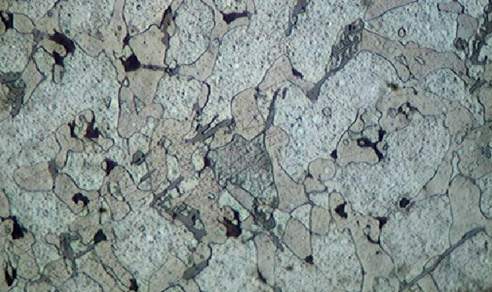 | Figure 1. Optical micrograph of slowly cooled Al-Zn-Mg-Cu alloy, x200 |
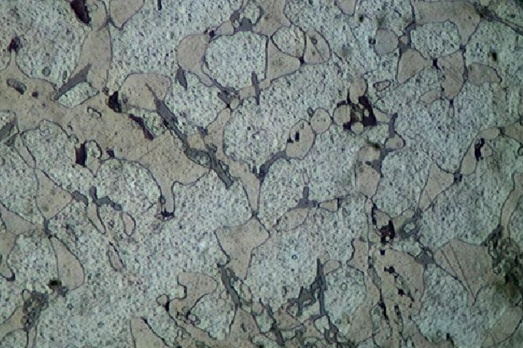 | Figure 2. Optical micrograph of rapidly cooled Al-Zn-Mg-Cu alloy, x200 |
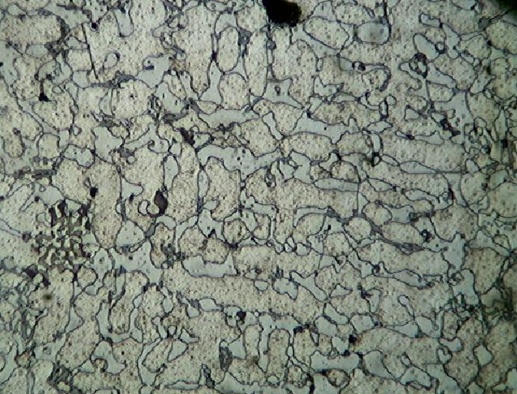 | Figure 3. Optical micrograph of annealed Al-Zn-Mg-Cu alloy, x200 |
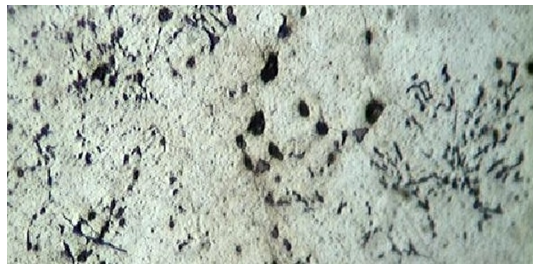 | Figure 4. Optical micrograph of T6 Tempered Al-Zn-Mg-Cu alloy, x200 |
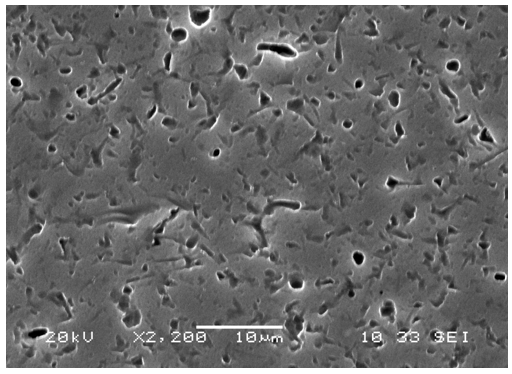 | Figure 5. SEM micrograph of T6 Tempered Al-Zn-Mg-Cu alloy |
|
4. Conclusions
- The following conclusions can be drawn from the results of this work.1) Gradual cooling of this alloy resulted in formation of microsegregations with its associated deleterious effects on the mechanical properties.2) Rapid solidification process, annealing and T6 tempering heat treatment operations eliminated the formation of microsegregations and significantly improved mechanical properties. 3) T6 tempering heat treatment operation was found to improve hardness value, yield and ultimate tensile strengths with a corresponding decrease in ductility. On the other hand, annealing heat treatment operation improved ductility but lowered hardness value, yield and ultimate tensile strengths. 4) Annealing treatment for this alloy will be suitable for designs and applications that require high toughness and ductility while age hardening treatment will be suitable for designs that require high hardness value, ultimate tensile and yield strengths. 5) The results of this research work would also help in ameliorating intergranular and stress induced corrosions as a result of removal of grain boundary segregations and stress; but further research work is required to confirm this.
 Abstract
Abstract Reference
Reference Full-Text PDF
Full-Text PDF Full-text HTML
Full-text HTML
